Little is known about the painter of the National Gallery of Art’s nineteenth-century American Still Life of Fruit, yet the composition suggests its creator’s...
Outliers and American Vanguard Artist Biographies
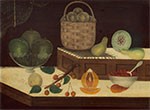
Still Life of Fruit, c. 1865/1880

Steve Ashby, late 1970s
Steve Ashby lived his entire life in a small town in Virginia, an unincorporated community roughly fifty miles west of Washington, DC. The son of an emancipated slave, he was the second of twelve children. Outside of a brief stint as a restaurant waiter, Ashby spent most of his life working the soil as a farmer and gardener until he retired in 1950...

Henry Bannarn, c. 1937
Henry Bannarn moved with his family from Oklahoma to Minnesota as a child. Through the support of philanthropist James Ford Bell, president of General...

Patrociño Barela and His Son, 1936
An integral figure in twentieth-century Hispanic and New Mexican art history, Patrociño Barela rose to art world celebrity in the 1930s, an unlikely prospect for someone of his background. He had left home at age eleven following the death of his mother and sister to travel around the Southwest in search of work...

Morton Bartlett, c. 1962
In many ways, Morton Bartlett’s art responded to his early loss of his family. Orphaned as a child and adopted by an upper-crust Boston couple, Bartlett attended Phillips Exeter Academy and Harvard College for two years, then dropped out and began to earn a living...

Mary Lee Bendolph, 2005
During the Great Depression, photographs and stories depicting the exceptional poverty of the rural community known as Gee’s Bend, Alabama...

James Benning, 2007
Before earning an MFA in filmmaking from the University of Wisconsin at the age of thirty-three, James Benning studied mathematics...

Forrest Bess, 1958
For more than twenty years, Forrest Bess worked as a bait fisherman on a remote island along the Gulf Coast of Texas, spending his nights and off-season days painting. He showed an early interest in art and studied architecture...

Camille Bombois, Self-Portrait, c. 1936
Although not overly given to art theory, Camille Bombois held fast to one principle: that the best art came from a life closely observed. Born in the Côte d’Or region of eastern France, Bombois grew into a strapping, muscular individual, who worked as a farmer, circus strongman, Paris subway builder, and newspaper machine operator...

Roger Brown, 1977
A keen storyteller, Roger Brown modeled his paintings on the narrative paradigms ...
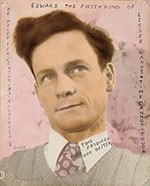
Eugene von Bruenchenhein
Eugene von Bruenchenhein spent his days laboring in a bakery in Milwaukee and his nights working on his multifarious artistic creations until he retired in 1959. He then devoted himself fully to his calling...
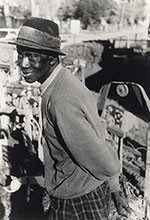
David Butler, c. 1970
David Butler was born twenty-five miles west of New Orleans in a small town situated on the banks of the Mississippi River. His father was a carpenter, and his mother served as a missionary with the Baptist church. Both had a profound influence on his sculptural style and the messages he conveyed through his art...

James Castle, c. 1962
In over five decades dedicated almost exclusively to art making, James Castle crafted a remembered and imagined universe in thousands of drawings, handmade books, and constructions. Using primarily stove soot and saliva on found papers such as flattened envelopes...

Pedro Cervántez, 1935–1943
Pedro Cervántez was born to parents of both indigenous Mexican and Spanish descent. He was interested in making art at a young age, but it was not until the 1930s, under the tutelage of Russell Vernon Hunter, an artist and state director of the WPA, that Cervántez...

Bruce Conner, 1965
In 1957 Bruce Conner dropped out of the MFA program at the University of Colorado in Boulder and moved to San Francisco. Arriving at the height of the Beat movement, he joined the experimental, underground artistic community that was flourishing in the absence of a viable art market...

Henry Darger, c. 1971–1972
“Unlike most children, I hated to see the day come when I will be grown up . . . I wished to be young always,” Henry Darger declared in his autobiography.[1] Inspired by L. Frank Baum’s Oz series and Harriet Beecher Stowe’s Uncle Tom’s Cabin, Darger wrote and illustrated a fifteen-volume book in which children...

Roy De Forest, late 1970s
Roy De Forest arrived in San Francisco in 1950 to attend the California School of Fine Arts (CSFA), then taught at the University of California, Davis, for almost three decades. Far from New York, the Bay Area fostered an aesthetic labeled “funk” by Peter Selz of the University of California’s Berkeley Art...
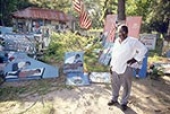
Sam Doyle, 1982
Sam Doyle grew up on Saint Helena Island, a remote South Carolina enclave populated mainly by the descendants of African slaves...

William Edmondson, Sculptor, by Edward Weston, 1941
Born at the dawn of the Jim Crow era, William Edmondson worked for a railroad company and then a women’s hospital before beginning to make and sell tombstones from the yard outside his home in 1931. Claiming divine inspiration, he soon branched out into garden ornaments and sculpture. In 1937 Harper’s...

Louis Eilshemius (seated), 1939
Louis Michel Eilshemius
Born into a wealthy family, Eilshemius received a prestigious education and upbringing. When he was eleven, his parents enrolled him and his brother in a school in Geneva, Switzerland, after which he continued his studies in Dresden, Germany...

Howard Finster,
inside his Bicycle Tower, 1986
Howard Finster began preaching at age sixteen. To support his evangelical work, which often involved traveling to give...

John Flannagan, c. 1930
Sculptor John Flannagan worked at the crossroads of modern art and forms then considered “primitive,” fusing Celtic, Mesoamerican, and medieval sources. As a young man, he studied painting at the Minneapolis Institute of Art before becoming a farmhand to the modernist...

Miss Van Alen, c. 1735
Generally untrained and itinerant, limners were a class of artists who helped shape the image of colonial Americans, securing the social status of their middle-class sitters in portraits that convey an air of refinement. “The Gansevoort Limner” designates an unidentified artist who was active in the US between 1730 and 174...

Lee Godie, c. 1985
For someone who worked and lived in the public eye for nearly thirty years, Lee Godie was tight-lipped about her private life. A Chicago native, Godie had married and raised a family, but in 1968, following the deaths of two of her children, she took to the steps of the Art Institute of Chicago and reinvented herself as an artist...

Marsden Hartley, c. 1910
Hartley lived a peripatetic life as he restlessly traveled throughout the US and Europe in search of modernist innovation and artistic discovery...

Palmer Hayden, 1950
Hayden was born Peyton Cole Hedgeman in a small Virginia town roughly fifty miles southwest of Washington, DC . After moving to DC at age sixteen to live with an aunt, he took a job as a general laborer for the circus. In 1912 he enlisted in the military, but due to a mistaken reference letter, he was registered as Palmer Cole Hayden...

Mary Heilmann, 1969
Mary Heilmann grew up primarily in San Francisco, where the Beats exercised an early influence on her sensibility. After studying poetry and literature, she earned a master’s degree in ceramics and sculpture from the...

Portrait of Edward Hicks by Thomas Hicks, c. 1850–1852
Apprenticed to Bucks County coach makers in 1793, Edward Hicks learned his trade as a decorative painter before entering the Religious Society of Friends and becoming a minister in 1811. Hicks’s talent for painting coaches and signs put him at odds with Quaker precepts favoring utilitarian simplicity...

Morris Hirshfield, 1940
Before he began to paint in 1937, Morris Hirshfield owned a business manufacturing women’s coats and suits as well as an extremely successful company that produced bedroom slippers. He showed his first canvases to John I. H. Baur...

Lonnie Holley, 1990
Lonnie Holley paints, carves in sandstone, and assembles cast-off objects into sculpture, such that the contemplative bent of his work renders him as much a diviner as an artist...

Jesse Howard, 1967
Jesse Howard once described himself as “an old dried-up farmer, wood-sawyer, sheepshearer, horse-shearer, and artist of sorts.” What began as his providing publicity for a friend’s annual exhibition of steam engines and antique farm equipment turned into a regular practice by the 1950s that transformed found materials into instruments of public self-expression...
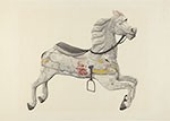
Index of American Design, c. 1939
Conceived as an effort to identify and preserve a national, ancestral aesthetic, the Index of American Design comprises 18,257 watercolor renderings of American folk and decorative arts objects from the colonial period through 1900...

Malvin Gray Johnson, Self-Portrait, 1934
Trained at the School of the National Academy of Design in New York, painter Malvin Gray Johnson first gained prominence in the city’s art world in 1928 when he began pictorially reimagining the African American spiritual...

William H. Johnson and Holcha Krake, c. 1935
Born in a small South Carolina town, William H. Johnson left for New York at seventeen and enrolled at the National Academy of Design in 1921. Though he originally intended to become a cartoonist, he won acclaim as a painter...

John Kane, c. 1928–1930
In 1879 John Kane, who was born to Irish parents in Scotland, emigrated to the US , where he was employed in various forms of manual labor. After losing a leg in a train accident in 1891, he began painting boxcars, signs, houses, and eventually canvases...

Yasuo Kuniyoshi, 1948
Yasuo Kuniyoshi emigrated to the US from Japan as a teenager in 1906. While studying at the Art Students League in New York, he made his debut at the First Annual Exhibition of the Society of Independent Artists in 1917...
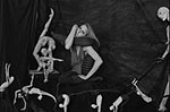
Greer Lankton, 1985
Greer Lankton is best known for her meticulously fabricated dolls: a motley, marginal cast of characters that includes circus performers and friends alongside the fashion elite...
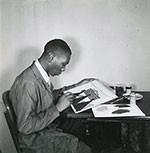
Jacob Lawrence, c. 1941
Jacob Lawrence’s family arrived in New Jersey as part of the “Great Migration,” the mass exodus of African Americans from the South. Lawrence showed an aptitude for painting as a child, then moved to Harlem in 1930...

Lawrence Lebduska, c. 1930
Although born in the US, Lawrence Lebduska spent his formative years in Leipzig, training in stained glass and studying with the Czech scenic designer Josef Svoboda. When he returned to the States in 1912...

Zoe Leonard, 2007
Zoe Leonard, who never formally studied photography, first rose to prominence after her participation in Documenta 9 in Kassel, Germany, in 1992, where she hung black-and-white photographs of female genitalia among the traditional paintings installed at the Neue Galerie...

José Dolores López, c. 1933
José Dolores López trained as a farmer and carpenter in the town of Córdova, about halfway between Santa Fe and Taos, New Mexico. Working in a traditional Hispanic aesthetic, López created hand-carved, brightly painted furniture and domestic fixtures along with highly decorative silver...

Séraphine Louis, c. 1930
Beginning in 1881 Séraphine Louis spent twenty years as a lay sister at a convent in northern France. She began to paint in 1903 after moving to Senlis to work as a housecleaner. She first decorated household items, then transferred her ornamental floral schemes onto small wooden or cardboard panels...

Al Loving, 1986
Al Loving studied painting at the University of Illinois, Champaign, before earning his MFA from the University of Michigan in 1965. Moving to New York City in 1968, he took up residence at the famous Chelsea Hotel and soon...

Sister Gertrude Morgan, c. 1974
By the time Sister Gertrude Morgan was making pictures regularly in the early 1960s, she had already spent nearly twenty years as a Holiness-Pentecostal missionary and street preacher. Drawings such as A POEM OF MY CALLING...
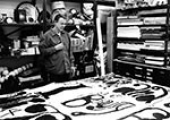
Matt Mullican, February 2005
Matt Mullican began to explore the outer reaches of subjecthood as a BFA student at CalArts in the legendary poststudio class of John Baldessari...

Elie Nadelman (center, looking over shoulder), c. 1915–1920
Born in occupied Poland, Elie Nadelman began his artistic training in Warsaw before leaving in 1902 to visit Munich, where he developed a passion for early Greek art. In 1905, soon after joining the Polish colony...

Senga Nengudi, in performance with Inside / Outside, 1977
While a graduate student at California State University in Los Angeles in the late 1960s, Senga Nengudi navigated between the Watts Towers Art Center (where she volunteered in the experimental community-based educational programs espousing an African American aesthetic)

Gladys Nilsson, 1967
Between 1966 and 1969, Gladys Nilsson, a recent graduate of the School of the Art Institute of Chicago, collaborated on a series of Hairy Who group shows with like-minded fellow alumni—including her husband, Jim Nutt, as well as Jim Falconer, Art Green, Suellen Rocca, and Karl Wirsum...

Jim Nutt, Self-Portrait, c. 1966
The fine draftsmanship and outlandish figures in Jim Nutt’s paintings conjure the sinuous lines and graphic distortions of American comic strips and Weimar-era caricatures by George Grosz and Max Beckmann. Nutt’s visual interests embrace these and many other sources, including self-taught art...

John Outterbridge, 1970
Assemblage is more than a medium for John Outterbridge; it defines a discipline of everyday living: “It seems that we all assemble notions, directives, disciplines, disappointments...

Dominique-Paul Peyronnet, n.d.
Dominique-Paul Peyronnet spent most of his professional life as a printmaker. He began working in a shop in Paris in 1902, gaining success and respect for his skill in color lithography. Military service during World War I...
Joseph Pickett never ventured far from New Hope, Pennsylvania, a town on the banks of the Delaware River. Working for the local carnival, he traveled through his native Bucks County, yet for most of his life he was a fixture in New Hope, working there as a craftsman and storekeeper. When he came to painting in his later years, his ambition was to depict the history and landscape of the region he knew so well...

Elijah Pierce and Cornelia Pierce, c. 1940
Elijah Pierce was the second-youngest child of a former slave. He led a transient life at first that included working as a barber’s assistant in Baldwyn...

Howardena Pindell, c. 1972
Howardena Pindell![]()
![]()
Howardena Pindell held positions at MoMA, first as an exhibition assistant and eventually as an associate curator of prints and illustrated books, after earning an MFA from Yale University in 1967. Throughout the 1970s Pindell also exhibited her abstract...

Horace Pippin, c. 1946
A military veteran wounded during World War I, Pippin was a self-taught African American painter who attracted attention amid the national fascination with “folk,” “primitive,” and “naïve” art in the late 1930s and 1940s...

Noah Purifoy, 1960s
Noah Purifoy served in the US Navy during World War II, then moved to Los Angeles, where he received his BFA from Chouinard Art Institute (now the California Institute of the Arts). After the Watts Rebellion of 1965...
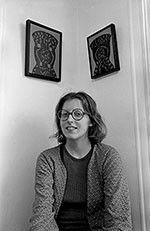
Christina Ramberg, c. 1974
Hair, fur, stilettos, satin, lace, and corsets embellish and constrict female bodies in the sensuous, sinister paintings of Christina Ramberg. Shown from the neck down or from behind, Ramberg’s women remain anonymous. Like the impersonal, mechanistic figures painted by Fernand Léger and Richard Lindner...

Martín Ramírez (at right), 1954
Recurring motifs in Martín Ramírez’s intricate drawings—equestrians brandishing pistols, the Virgin of the Immaculate Conception...

Barbara Rossi, 1979
When Barbara Rossi first exhibited her work in 1970, she was a natural fit among a nascent group of artists known today as the Chicago imagists...

Henri Rousseau, 1910
Despite his nickname, “Le Douanier,” Henri Rousseau actually worked as a municipal inspector, not a customs officer, before his 1884 retirement. Self-taught as an artist...

Betye Saar, 1975
Profiting from formative encounters with craft, design, and the work of Joseph Cornell in the early 1960s, Betye Saar shared an affinity with American jazz composer Sun Ra and others for the liberation afforded by mystical cosmologies...

Judith Scott, c. 1998
During the eighteen years that Judith Scott made objects, her artistic idiom remained constant: totem- and cocoonlike sculptures of layered fibers, fabrics, and other materials deftly woven over an armature of quotidian items. Her sculptures range from relatively spare...
![Untitled [Nancy Shaver] by Walker Evans, 1973 Untitled [Nancy Shaver] by Walker Evans, 1973](/content/ngaweb/features/exhibitions/outliers-and-american-vanguard-artist-biographies/jcr%3acontent/parmain/textimage_189689750/image.img.jpg/1516551901943.jpg)
Untitled [Nancy Shaver] by Walker Evans, 1973
Growing up in a rural, working-class town in Upstate New York, Nancy Shaver was drawn to making compositions of ordinary, unpretentious materials and objects...

Charles Sheeler, Self-Portrait, after 1932
While the art of Charles Sheeler is strongly associated with industrial landscapes and towering skyscrapers, his vision of the modern was equally defined by an engagement with preindustrial artifacts and domestic spaces...

Cindy Sherman, 1981
In 1977, after completing a BFA in photography at Buffalo State University, Cindy Sherman had just moved to New York City when she visited the downtown loft of painter David Salle...

Alan Shields, early 1970s
Drawing on skills first learned at home on his family’s farm, Alan Shields began to use sewing machines to create drawings in thread while studying civil engineering...
![Lorna [Lorna Simpson] by Chuck Close, 2006 Lorna [Lorna Simpson] by Chuck Close, 2006](/content/ngaweb/features/exhibitions/outliers-and-american-vanguard-artist-biographies/jcr%3acontent/parmain/textimage_1187540858/image.img.jpg/1516552509721.jpg)
Lorna [Lorna Simpson] by Chuck Close, 2006
A graduate of New York’s School of Visual Art, Lorna Simpson pursued her MFA at the University of California, San Diego, in the mid-1980s, which placed language, feminism, and critical use of photography and film at the center of her practice...

Drossos P. Skyllas, Self-Portrait, n.d.
Drossos Skyllas achieved the exquisitely detailed, jewel-like surfaces of his paintings with tiny brushes he fashioned himself. He applied miniscule dabs of luminous oil paint in a pointillist manner, which gave his subjects a petrified yet shimmering quality...

Janet Sobel, c. 1944
Janet Sobel, born Jennie Lechovsky, emigrated to the US from Ukraine in 1908 after her father was killed in an anti-Semitic pogrom. She began to paint in 1939, when she was forty-five and living in Brooklyn with her husband, a manufacturer of costume jewelry...
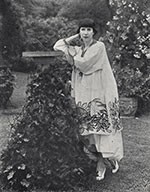
Florine Stettheimer, c. 1910
Florine Stettheimer, born in Rochester to a wealthy German Jewish family and raised partly in Stuttgart and Berlin, traveled widely and was living in Munich at the onset of World War I. When she returned to New York City in 1914...
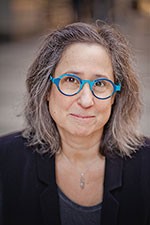
Jessica Stockholder, 2016
Jessica Stockholder grew up in Vancouver, taking private drawing lessons with Canadian artists Nora Blanck and Mowry Baden before enrolling in the BFA program at the University of Victoria. Receiving her MFA from Yale University in 1985...

Patrick J. Sullivan, n.d.
“You remember the old saying,” Patrick Sullivan once explained. “‘A lie is the truth in disguise.’ It is my intention to bring truth out in all its glory on my canvases . . . a sort of parable in picture form.”...

James “Son Ford” Thomas, 1971
As a child, James Thomas earned his nickname by modeling Ford tractors out of the red “gumbo” clay found in the hills of Yazoo County. He later adopted the moniker as a blues performer playing the Mississippi Delta region...

Edgar Tolson and his children, late 1960s
Edgar Tolson’s austere wooden figures, around twelve inches tall, all have distinct personalities, thanks to his careful delineation of details such as eyebrows...
Rosie Lee Tompkins is the pseudonym of quilter Effie Mae Howard, who carefully guarded her privacy after her rise to national prominence in the late 1990s...

Bill Traylor, c. 1939
Born into slavery, Traylor is believed to have produced most of his existing work after he moved to Montgomery, Alabama, in 1939. He received support early in his career from Charles Shannon, an artist from Montgomery who...
“Type 42” is the name of a black-and-white film stock made by Polaroid between 1955 and 1992. In 2012 the artist Jason Brinkerhoff discovered a cache of around 950 images taken on Type 42 film by an unknown photographer...

Kara Walker, 2006
Kara Walker![]()
![]()
Kara Walker once explained her artistic process as “two parts research and one part paranoid hysteria,” a description that captures the entanglement of history and fantasy that pervades her work...
P. M. Wentworth’s forty or so known drawings are as mysterious as they are riveting. His interpretations of iconic biblical themes such as the Creation and Crucifixion emphasize their cosmic scale through details like radiant beams streaming from stars and moon...

H. C. Westermann, 1975
H. C. (Horace Clifford) Westermann worked variously as a gandy dancer, sailor, acrobat, and carpenter. And he brought the considerable physicality...

William Wiley, 1992
William T. Wiley![]()
With repurposed materials and characteristic wit, William Wiley’s Canjo relishes the inventiveness that transforms simple materials into an aesthetically rewarding object. A plain woven...

Joseph Yoakum, 1967
Joseph E. Yoakum![]()
![]()
Joseph Yoakum experienced firsthand the golden age of the American railroad and circus, instilling in him a lifelong wanderlust. Though he claimed his birthplace was a Navajo reservation in Arizona...

Annie Mae Young, 2001
Annie Mae Young made her first quilt while still a child, following knowledge traditionally handed down from mother to daughter in the region. It was a photograph of one of Young’s quilts around a half a century later that launched the quilters of Gee’s Bend...
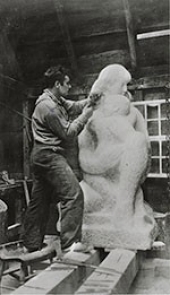
William Zorach Carving “Mother and Child” by Charles Sheeler, c. 1927
William Zorach emigrated from Lithuania in 1891 and studied painting in Cleveland, Ohio, while training in lithography. He moved to New York in 1907 to study painting at the National Academy of Design...